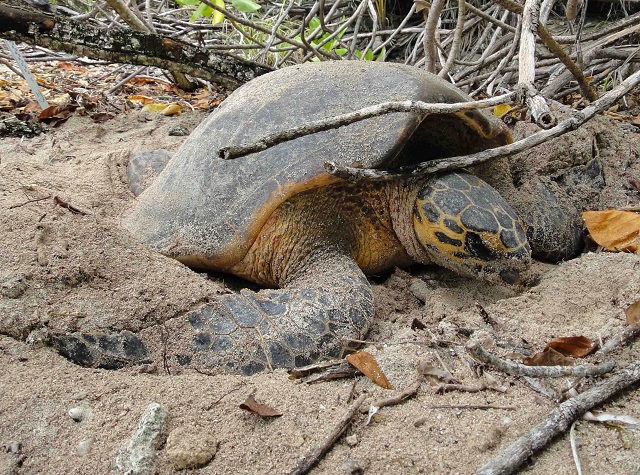The Seychelles’ Department of Environment has observed a drastic increase in sea turtle poaching and has therefore increased its monitoring and surveillance efforts, said a top official.
The department’s director of conservation, Ashley Dias, told SNA on Thursday that the nesting season has barely started and the authorities have recorded 14 cases of poaching compared with eight cases for the whole season last year.
“As a result conservationists have increased monitoring efforts and surveillance, patrolling the beaches where we know turtles come to nest. We are also going hard on our educational programme to sensitise the public on the danger and consequences of poaching,” said Dias.
Seychelles, an archipelago in the western Indian Ocean, is home to one of the world’s largest populations of green and hawksbill turtle.
The green turtle breeds all over the islands throughout the year, unlike the hawksbill turtle which breed mostly between mid-October and mid- January. Both species are on the International Union for Conservation of Nature’s (IUCN) red list. Green turtles are classified as endangered while the hawksbills are critically endangered.
The hawksbill turtle is listed as critically endangered. (Jeanne Mortimer) Photo License: All Rights Reserved
Dias said that more poaching is occurring in the southern part of the main island of Mahe because the beaches are more isolated and out of sight, making it easier for poachers to go undetected.
“Therefore we are asking members of the public to give a helping hand and to report on any suspicious activities,” said Dias.
Sea turtles in Seychelles are protected under the Wild Animals and Birds Protection Act and the penalty for offences is up to two years in prison and a fine of up to $37,000.
Despite the strict laws, poaching is still a major concern because of the country’s tradition of eating turtle meat as a delicacy. In most cases, because they are the ones that lay eggs, females are more vulnerable.
Dias said the Department is going to review existing laws “for stricter measures and penalties to deter poaching.”
Apart from human-related threats, other menaces include marine debris, eggs that are washed away by waves and steep crests and obstacles inhibiting the female’s progress across the beaches to lay eggs. Once hatched, babies are a favourite food for ghost crabs, birds, and fish.
Environment officers together with the Marine Conservation Society of Seychelles investigating a poaching incident in 2017. (Department of Environment) Photo license: CC-BY
Another emerging threat is dogs frequenting beaches and digging up eggs from the nesting holes. Dias said that “with the introduction of the new Dog Act we would be able to have better control.”
The Control and Protection of Dogs Act 2018 is set to come into effect on January 1. The legislation makes provision for the protection of dogs and places the regulatory-responsibility on dog-owners.
Sea turtles lay around 150 to 200 eggs depending on species and that takes around two to three hours. The hatchlings will emerge after eight weeks of incubation.
Conservation efforts are also being done by businesses especially hotels such as the Bayan Tree resort where guests can also witness this beautiful natural phenomenon of marine turtles nesting on the resort’s beach.
The resort works closely with the Marine Conservation Society of Seychelles (MCSS) to monitor turtle activity on the Intendance Bay as part of the MCSS’ conservation efforts. Last season they calculated at least 10,000 new hatchlings making their way into the water.
Source: Seychelles News Agency

